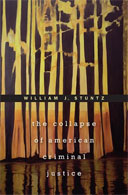The Collapse of American Criminal Justice

Author: William J. Stuntz
Cambridge, MA: The Belknap Press of Harvard University Press, 2011. 413p.
Reviewer: Samuel W. Buell | March 2012
Bill Stuntz was a man of enormous courage and generosity. As family, friends, and colleagues have attested, he spent much of his last years and months—in the teeth of great suffering—giving us a book summarizing his case against the American criminal justice system that all of us in the field will dog-ear and cite for the rest of our careers. Of course, Stuntz’s courage was evidently hard-wired long before his physical ordeals. His life’s work is a model of the scholar who masters the content of his field and then—with style and authority—proceeds to buck conventional wisdom, pursue sacred cows, feast on the paradoxical and counterintuitive, and embrace a practice of mapping the forests and their interdependencies, while others are looking at a single wood or progressing tree by tree.
In The Collapse of American Criminal Justice, Stuntz extends his familiar intellectual courage, in two ways. First, he adds a third dimension to his work as he had not fully done before. Long the master of getting substance and procedure, or politics and law, moving together in elegant and illuminating detail, here Stuntz extensively deploys history, giving his picture a temporal depth that adds force and appeal to his previous accounts of the contemporary legal system. Second, Stuntz offers a plethora of causal claims and prescriptions—in the admitted absence of available empirical proof—that are more provocative, daring, and sweeping than the many signal insights found in his line of brilliant pieces for law journals.
Collapse is a book that will be devoured by all in the field, not to mention the broader audience that already is embracing it, so I will skip the usual summary here. (One can find highly informative reviews online from the likes of Paul Cassell, Orin Kerr, Richard Posner, and John Paul Stevens.) Collapse is also a book to be argued with. In this brief review, I intend simply to identify some of Stuntz’s most arguable claims (which naturally happen to be among his most interesting ones), and to suggest a bit about the nature of the arguments he has started. Here are a few:
Past iterations of the American criminal justice system, particularly in northern states in the late 19th and early 20th centuries, treated people more fairly. Stuntz’s main evidence for this point—aside from his gestalt sense as a devoted student of the history—is lower rates of incarceration and higher rates of acquittal. It is more than plausible that the smaller-scale and enormously less bureaucratized systems of these eras would have looked less like sausage factories than the plea bargaining mills of today.
But how do we know that rule-of-law values held greater sway in these systems? Stuntz has to carve out from his claim—at great and not always plainly relevant length—most (but not all) of the southern experience, for obvious reasons. And I, at least, was not convinced that lots of murder acquittals in good old Chicago, for example, necessarily signaled something like fairness or (appropriate) mercy, rather than, say, unprofessional prosecutors or capricious juries. There is much to lament in the rigidity of our modernized criminal justice system—and Stuntz is a lamenter nonpareil—but a lot of that rigor has been created at least in the name of fairness, if not in its service. Before the Second World War, let us not forget, there were no Federal Rules of Criminal Procedure, no Gideon, no Batson, no ABA Model Code of Professional Responsibility, and so on.
The fuzzy, morally charged mens rea concepts of the common law and its judges were superior to the technical, forensic, and statutory mens rea rules produced by 20th century criminal law reform, as exemplified by the American Law Institute’s Model Penal Code. Herbert Wechsler, lead drafter of the Model Penal Code, comes in for harsh treatment from Stuntz. I am not sure it is fair treatment because Stuntz does not engage in (or even with) any extended analysis of modern mens rea concepts—of the sort with which scholars like Ken Simons, Larry Alexander, and Kim Ferzan have been busy. In Stuntz’s account, cognitive concepts such as intent and knowledge do not sort well for blameworthy actors when applied to criminal offenses outside the core of murder, rape, robbery, and the like—while the old Blackstonian ideas about fault did a nice job of sorting the more deserving killers from the lesser ones.
Of course, the claim only works if one thinks, as Stuntz comes very close to saying, that the criminal code should be radically pared back to some core of, shall we say, “original” crimes—and that projects of using criminal sanctions to regulate new and dangerous behaviors (or ones newly appreciated as dangerous) ought to be abandoned. Even still, one has to think that the killers most harshly condemned by yesterday’s juries—licensed by common law concepts to be blame entrepreneurs—were the most deserving ones. Again, evidence of higher rates of acquittal does not seem to quite prove the point. (I must add that Stuntz’s assault on Wechsler and his fellow-traveling law professors especially weakens when Stuntz draws an implausible connection between the ALI’s project and the efforts of Antonin Scalia and followers to eradicate purposivism in the judicial treatment of statutes.)
Generally speaking, the more localized is a criminal justice system, the more fair and restrained it will be; modern regionalization (and, to a lesser extent, federalization) of criminal justice have made the system more punitive and discriminatory. Stuntz has lots of examples for this point, including ones he fairly includes as exceptions to his general rule. His historicism, which he admits is somewhat casual, is entertainingand illuminating. I will leave it to the historians to take any necessary issue with Stuntz’s accounts of the politics of Reconstruction, Gilded Age, and Prohibition criminal justice. But I think Stuntz does not say enough about present implications of what even he acknowledges to have been exceptions to the rule in some places and at some times, most obviously for blacks in the Jim Crow south. Whether you like localism in criminal justice depends even today, more than Stuntz acknowledges, on who you are and where you sit.
The media and academic journals are filled with accounts of local law enforcement structures corrupted by bribery and kickback schemes, venal district attorneys who suppress evidence to win cases, counties (including lots of small and rural ones) in which capital punishment systems exhibit no genuine adversarial qualities, botched inquiries by underfunded and unprofessional investigators, alarmism about sex offenders in the neighborhood, and bureaucratic police initiatives that produce grossly racially disparate practices of traffic and street stops. More to the point, what would Stuntz say about the zeal of groups, communities, and officials in states like Alabama and Arizona to herd undocumented immigrants into the criminal justice system? To be sure, there has been some evidence of county-level resistance to state-level efforts in that realm. But immigration politics produces no story about suburbs and urban cores that maps onto Stuntz’s extended account of the development of what we might call white-black criminal justice from the late 1960s through the 1990s.
Lots of discretion is good, as long as it is distributed to all actors in the criminal justice system. Stuntz likes jury discretion (which depends on frequent trials, loose instructions, and robust nullification norms) because it tends to reduce imprisonment, involve communities in regulating their own crime problems, and check prosecutors from bringing weak cases and ones involving relatively blameless defendants (and, by extension, from extracting pleas too easily). He likes judicial discretion because it allows courts to fashion constitutional rules that could beneficially regulate both the content of substantive criminal law and the charging decisions of prosecutors. (Though he does not like that judges have failed to exercise discretion to those ends.) Stuntz does not like prosecutorial discretion—at least not if there is too much of it and it is too removed from tight democratic controls—because it produces a plea-dominated system that suppresses from scrutiny questions about desert of punishment and equality in treatment, especially on the dimension of race.
Stuntz does not, however, really explain why jurors and judges are more likely to make socially beneficial decisions than prosecutors. In his model, prosecutors are the two-dimensional self-maximizers of the criminal justice economy whose discretion, in his words, breeds discrimination. Judges and jurors are something else. Of course, much of Stuntz’s point is, and long has been, about balance. More discretion for judges and juries means less for prosecutors, and that gets things back in kilter. But we need to ask which kind of kilter we prefer: lots of discretion spread around, producing some hopefully nice balance; or lots of controls and constraints forcing everyone in the system to act more predictably and law-like, producing some set of hopefully less draconian and discriminatory outcomes.
James Madison and Earl Warren, well intentioned as they were, bear considerable responsibility for the ills of the present American criminal justice system. Of course the procedural protections of the Fourth and Fifth (and even Sixth) Amendments have not and cannot deliver the constraints on imprisonment and guarantees of factual accuracy that today’s reform-minded people most keenly desire. But Stuntz, as many know, goes far beyond disappointment with the drafting and interpretation of Bill-of-Rights criminal procedure rules: He blames the dominance of proceduralist thinking, with its focus on investigative practices, for diverting everyone’s attention from control of the crime definitions and prosecution decisions that he says largely produce current punitive excesses. Then he goes farther, to assert that litigation of procedural issues distracts defense lawyers from investigating facts and contesting merits, thereby decreasing acquittals and accuracy.
Many will be familiar with Stuntz’s Warren Court claim, which has been perhaps his most debated contention; others have covered this ground. I will point out only that this claim shares both the attraction and the weakness of many of Stuntz’s major arguments in Collapse. He keeps offering diagnostic claims about pathologies (Stuntz has earned a trademark on usage of the word in law) that are gloriously insightful and usually indisputable. But these discoveries are bundled for sale with claims about etiology that, while making everything seem to fit together in a kind of natural picture of causal flow, can leave one quite empirically uneasy. To take just the present example, we need believe that American defense lawyers would succeed in exonerating more innocent (and perhaps weakly guilty) people if only they were not distracted by the nuisance of motions to suppress—which, in Stuntz’s account, seem to lure lawyers in because they offer relatively easy means of winning cases yet at the same time fail to keep prison populations down.
In all of his work, Stuntz bravely—and, best, without any boring ideology—took on what might be the core structural problem of criminal justice in a liberal legal order: How do we find the mix of discretion (or, if you prefer, play in the joints) and rule-of-law constraints that will produce a fair, moderate, affordable, and security-enhancing system? After reading Collapse, I tend to feel discouraged—perhaps for reasons more profound than those affecting Stuntz. The short list above of some of the arguments his book provokes reveals the dilemma’s severity. Even Stuntz, with his prodigious skills, ends up painting himself into some corners. One completes the last chapters wondering, for example, how Stuntz can blame the federal sentencing guidelines—principally designed to promote equity in punishment—for producing badly skewed outcomes through their rigidity, while promoting the idea that a new system of data-driven controls on enforcement decisions, centered on offender and offense characteristics, would deliver equality in outcomes. Or how Stuntz can blame modern statutory crime definition for stamping out the possibility of mercy by judges and juries, while lamenting that the enduring breadth of white-collar crimes like fraud, which are still mostly judge-made, contribute to the construction of plea bargain factories managed by prosecutors.
But we should not fret too much. Stuntz may have come closer than anyone has to a comprehensive explanation of what has gone wrong with American criminal justice, the sick man of our legal institutions. One cannot dismiss Stuntz, as Richard Posner comes close to doing (The New Republic, 10/26/11), because, in proposing novel forms of judicial review, Stuntz comes off as just as hubristic as the Warren Court; or because Stuntz offers only causal hypotheses that, according to Posner, need “testing” by “social scientists.”
Proving causal claims in this realm with quantitative empirical methods continues to be nigh impossible, and will be for the foreseeable future, as Posner concedes. Besides, as Stuntz would have been painfully aware as he worked to complete this project, the data are not yet in on the effects of either the modern incarceration boom or the big crime drop. In the absence of decisive quantitative insights, and as our prisons continue to embarrass us every day, scholars of both a positive and normative bent are obliged to seek and debate explanations and prescriptions. Stuntz’s suggestions about alternative constitutional paths are performance of duty, not hubris.
Many of us in criminal law and justice having been asking ourselves since Bill Stuntz grew seriously ill, “What ever would we do without him?” He took care of some of the problem for us: We will argue with the book he made sure to leave us. I wish I could thank him for that legacy.
Samuel W. Buell is Professor at Duke University School of Law.


